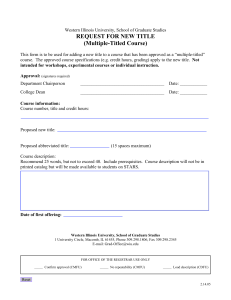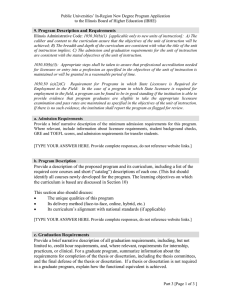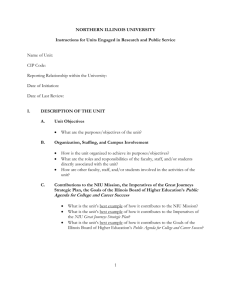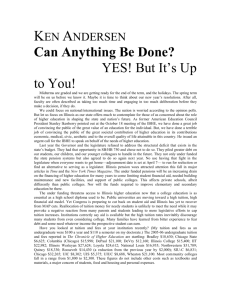New IN REGION Program Approval Application Part4
advertisement
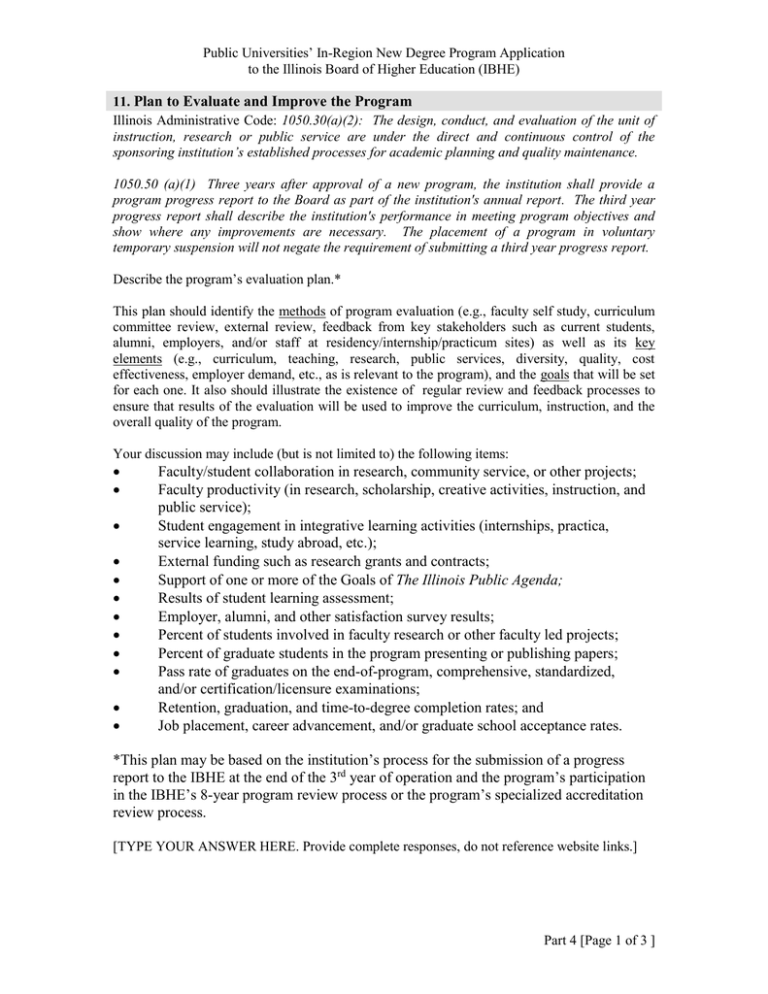
Public Universities’ In-Region New Degree Program Application to the Illinois Board of Higher Education (IBHE) 11. Plan to Evaluate and Improve the Program Illinois Administrative Code: 1050.30(a)(2): The design, conduct, and evaluation of the unit of instruction, research or public service are under the direct and continuous control of the sponsoring institution’s established processes for academic planning and quality maintenance. 1050.50 (a)(1) Three years after approval of a new program, the institution shall provide a program progress report to the Board as part of the institution's annual report. The third year progress report shall describe the institution's performance in meeting program objectives and show where any improvements are necessary. The placement of a program in voluntary temporary suspension will not negate the requirement of submitting a third year progress report. Describe the program’s evaluation plan.* This plan should identify the methods of program evaluation (e.g., faculty self study, curriculum committee review, external review, feedback from key stakeholders such as current students, alumni, employers, and/or staff at residency/internship/practicum sites) as well as its key elements (e.g., curriculum, teaching, research, public services, diversity, quality, cost effectiveness, employer demand, etc., as is relevant to the program), and the goals that will be set for each one. It also should illustrate the existence of regular review and feedback processes to ensure that results of the evaluation will be used to improve the curriculum, instruction, and the overall quality of the program. Your discussion may include (but is not limited to) the following items: Faculty/student collaboration in research, community service, or other projects; Faculty productivity (in research, scholarship, creative activities, instruction, and public service); Student engagement in integrative learning activities (internships, practica, service learning, study abroad, etc.); External funding such as research grants and contracts; Support of one or more of the Goals of The Illinois Public Agenda; Results of student learning assessment; Employer, alumni, and other satisfaction survey results; Percent of students involved in faculty research or other faculty led projects; Percent of graduate students in the program presenting or publishing papers; Pass rate of graduates on the end-of-program, comprehensive, standardized, and/or certification/licensure examinations; Retention, graduation, and time-to-degree completion rates; and Job placement, career advancement, and/or graduate school acceptance rates. *This plan may be based on the institution’s process for the submission of a progress report to the IBHE at the end of the 3rd year of operation and the program’s participation in the IBHE’s 8-year program review process or the program’s specialized accreditation review process. [TYPE YOUR ANSWER HERE. Provide complete responses, do not reference website links.] Part 4 [Page 1 of 3 ] Public Universities’ In-Region New Degree Program Application to the Illinois Board of Higher Education (IBHE) 12. Budget Narrative Fiscal and Personnel Resources Illinois Administrative Code: 1050.30(a)(5): A) The financial commitments to support the unit of instruction, research or public service are sufficient to ensure that the faculty and staff and support services necessary to offer the unit of instruction, research or public service can be acquired and maintained; B) Projections of revenues necessary to support the unit of instruction, research or public service are based on supportable estimates of state appropriations, local tax support, student tuition and fees, private gifts, and/or governmental grants and contracts. Budget Rationale Provide financial data that document the university’s capacity to implement and sustain the proposed program and describe the program’s sources of funding. a. b. c. d. e. f. g. h. Is the unit’s (Department, College, School) current budget adequate to support the program when fully implemented? If new resources are to be provided to the unit to support the program, what will be the source(s) of these funds? Is the program requesting new state funds? (During recent years, no new funds have been available from the state (IBHE) to support new degree programs). Will current faculty be adequate to provide instruction for the new program or will additional faculty need to be hired? If additional hires will be made, please elaborate. Will current staff be adequate to implement and maintain the new program or will additional staff be hired? Will current advising staff be adequate to provide student support and advisement, including job placement and or admission to advanced studies? If additional hires will be made, please elaborate. Are the unit’s current facilities adequate to support the program when fully implemented? Will there need to be facility renovation or new construction to house the program? (Refer to Section #13.1). Are library resources adequate to support the program when fully implemented? (Refer to Section #13.2). Are any sources of funding temporary (e.g., grant funding)? If so, how will the program be sustained once these funds are exhausted? If this is a graduate program, please discuss the intended use of graduate tuition waivers. If the program is dependent on the availability of waivers, how will the unit compensate for lost tuition revenue? Complete the budget Table 2 below [TYPE YOUR ANSWER HERE. Provide complete responses, do not reference website links.] ESTIMATED COSTS OF THE PROPOSED PROGRAM 5th Year Category Personnel Faculty Faculty Unit of Measurement FTE $ Year One $ # $ (or when fully implemented) $ # $ Part 4 [Page 2 of 3 ] Public Universities’ In-Region New Degree Program Application to the Illinois Board of Higher Education (IBHE) Other Personnel Costs Supplies, Services, Equipment1 $ $ $ $ $ $ Facility Costs (e.g., rental, maintenance) Other Costs (itemized): $ $ $ $ $ $ $ $ $ $ $ $ Total $ $ $ $ Part 4 [Page 3 of 3 ]
